
Andrea Helmuth
Tokyo Marathon (English Version) 2012
Nothing is impossible
The alarm was sounded when the sighting of a battered and bleached wooden ship with its sails in tatters glided uncontrollably into the harbor. At the end of nineteen catastrophic months, William Adams and twenty-four desperately ill and dying crew members arrived off the island of Kyūshū, Japan.
They had crossed the Atlantic and Pacific oceans, had survived Antarctic and tropical conditions. William Adams had made it to Japan and so had we. Shorty before landing I was awoken by the flight attendant who was announcing our arrival at the international airport of Narita. In my hands, I was holding Giles Miltons book “Samurai William: The Englishman who opened Japan” who in 1600 became stranded in Japan. What adventures await us?
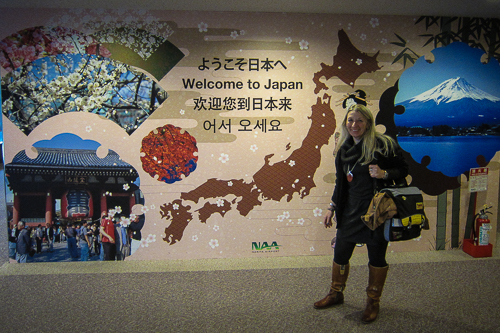
It’s daytime, my body is telling me it’s nighttime. I have forgotten how many hours separate me from home. For approximately 11 hours we were held captive in the belly of the Airbus 380. Now the giant regurgitated over 500 passengers with their baggage. Did you know that 9 out of 10 suitcases and bags that are used for travelling are black? Of course, ours too! When they finally arrive at baggage collection and the carousel swung into action, the tension is noticeable among the guests who hope to snag the correct luggage. Friendly customs personnel check the validity of our passports. We do not need a visa. Welcome to the multimillion inhabitant metropolis of Tokyo.
Sightseeing as an adventure
Of course we know Japan – if only from the school atlas, longitude, latitude, rivers and cities. The underground map resembles a crossword puzzle, but what do you do when you can’t even read it?
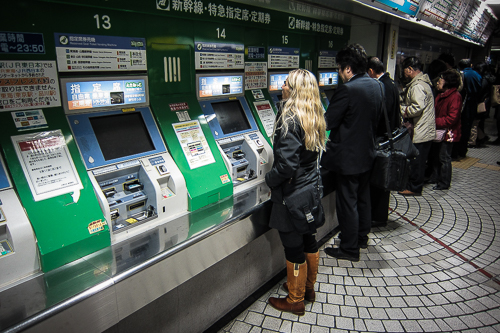
A taxi is out of the question because a trip will cost €250. In Germany we bought a Japanese rail pass. This is the best and cheapest way to travel in Japan, at least for the long distances. Be careful though, you can’t buy this pass when you are already in Japan and it is only for tourists that are visiting the country. Only 60 Kilometers divide us from the city, where over 10 million people live, and over 800,000 businesses are run. It is 8.30 a.m. We have only been in the country one hour and we have managed to hit the rush hour, my worst nightmare. Thousands of people are making their way to work. The trains are so full. Men in uniforms wearing white gloves are cramming the commuters into the trains. If the doors can’t close, they pull some of the commuters back out. The passengers are quiet, nobody talks, nobody telephones, and there is no annoying loud music. The commuters are squashed in like sardines in a tin. This is certainly not for the faint hearted or those that suffer from claustrophobia. We arrive at the biggest train station in the world and can thankfully get out. The train station is spotless, no litter to be seen anywhere.
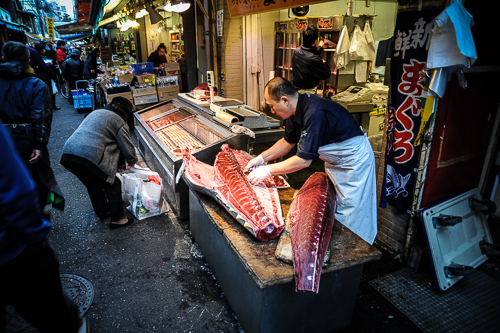
Tokio Hotel
New lodgings – that is the translated name of the district Shinjuku. It is a major commercial and administrative centre, housing the busiest train station in the world. Unprecedented service is part of the package as two maids chaperone us to our room without expecting a tip, which hence they wouldn’t accept anyway. But, smiling and bowing which holds a high status in Japan, and is a thank you of its own. The lift that takes us to our room unfortunately stops on the 12th floor. Our hotel is not new, but with 1,440 rooms belongs to one of the highest hotels in Tokyo. When the weather is good, so they tell us, one can see Mount Fuji (Fuji-San) 120 Km away. What we, however, can see is the beautiful Town Hall. With its twin towers it reminds us of the Notre Dame in Paris. This will be the start line of the marathon. Late into the evening we can still see the lights on in office buildings. Wearing “Yukata” bathrobes we are fixated by the sights around us and we feel like Bill Murray and Scarlett Johansson as lost guests in Tokyo in the film “Lost in Translation”.
Pachinko and traditional food in the heart of an illuminated business Temple
Our curiosity and hunger drives us onto the streets of Shibuya. Blinking neon advertisements and video clips on huge screens, loud amusement arcades, karaoke bars, and advertisements of all sorts defacing high rises. Here to be found a patchwork of pedestrian crossings on one of the busiest crossroads in the world. Waves of people surge across the streets on green and as regimented and disciplined as army cadets stop on red.
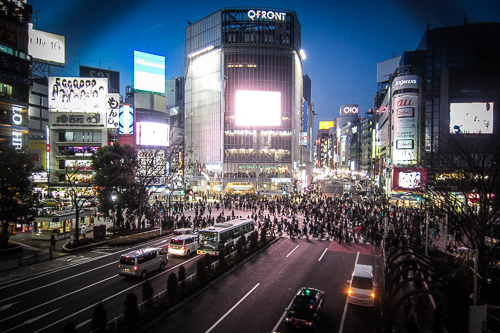
There are roughly as many restaurants as in Pachinko temple. Young women shout incessantly into megaphones to draw customers, which appears to be very successful. We enter through an electric, sliding glass door into an amusement arcade and observe housewives, workers, students and retirees sitting back to back in endless lines staring at tall gaming machines in which thousands of silver colored balls zip around. With a knob you can control the speed of the gaming ball through the labyrinth of nails. It’s grotesquely loud. Blaring Japanese pop music and vocal advertisements permeate the air.
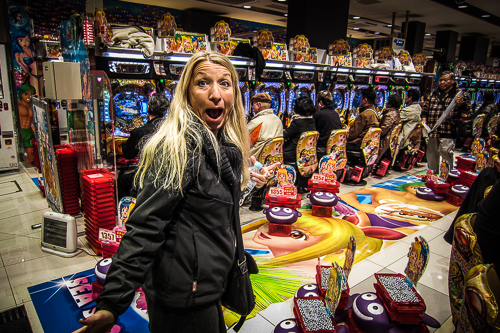
To top it off there is a hazardous blanket of cigarette smog that chokes the lungs and flight back into the open is our only option. This is truly an odd atmosphere and a world which is totally foreign to us. For many Japanese the lure and glitz is irresistible. Apparently, unofficially, there are 30 million hardcore game players and 20 million casual players in Japan.
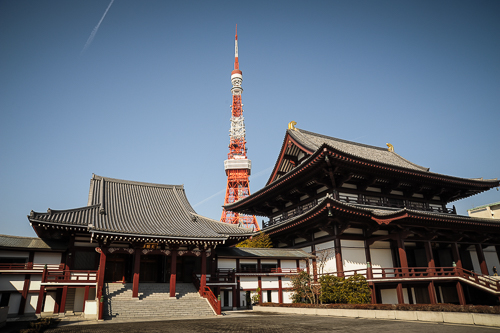
Once outside, an American fast food chain offers with its burgers not ketchup, but Teriyaki, a sweet soya based sauce. My desire for rice pudding with sugar and cinnamon will have to wait until our return to Germany, as the Japanese believe rice made with milk is a spoil of their valuable and staple diet.
Ahead I see Ramen and Udon, a restaurant that sells the typical Japanese noodle soups; the cheaper alternative to satisfy the hunger. Also on the menu, the Chanko-nabe, a rich vegetable stew which is the favorite dish of the Sumo wrestlers. We can’t decide. An hour later we find ourselves in a restaurant pointing at a picture on the wall, a big bowl of soup with a type of macaroni and egg. Kay takes the macaroni and I a rice dish. With chop sticks and food in hand we make our way over to a round table where locals are sitting. They don’t take any notice of us when we sit down, but just continue slurping noisily at their soup. We are served with water and steaming, perfumed green tea that is free with every meal. Whatever you do, don’t help yourself. Kay poured my tea and I his. In Japan this is customary. The smell of the food that stifles the air makes my nose start to tickle. Kay offers me a tissue. I stab my chop sticks into my rice and hastily make my way to the rest rooms. Even blowing your nose in public is seen as rude, just as it is back-home. Even still, without knowing, I managed to embarrass myself by leaving my chop sticks in my food; this is done only in memory of the dead!
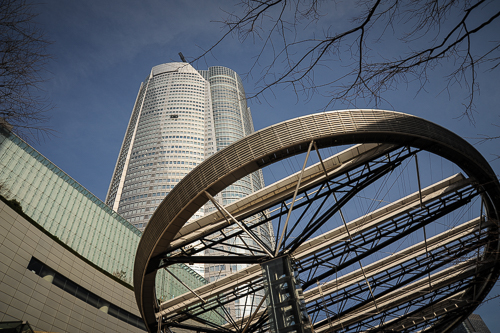
This strange world of mysterious letters, pronounced polite rituals, and a Buddhist like serenity, combined with the fast paced, high technology jungle fascinated us. At home the horrified questions from our families and friends: “Where are you going, to Japan?” “Is Tokyo safe?”; “is it dangerous there?”; “The earthquakes?”; “The radiation?”; “What about the food and the water?” The questions are of course legitimate and are on our minds too. After all, it is soon the anniversary of the cataclysmic Tsunami and the reactor meltdown. The “Japan Times” publishes daily a radiation map.
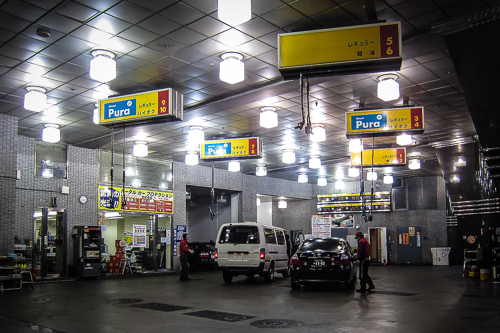
Today, in Fukushima radiation is at 2.56 micro-sievert per hour. In Tokyo it’s 0.058 micro-sievert. Interestingly, in Berlin the partner city to Tokyo the reading is 0,070-0.079. Is this a reason not to visit Berlin? And: nowhere else in the world do the people live as long as they do in Japan. That can’t be a fluke, can it? Who knows, maybe we can find out the mystery behind the 100 year olds.
The Friendship Run as warm up to the marathon
The early bird catches the worm. We really tried to sleep, but we just couldn’t . It’s Saturday, and after being awake for 35 hours, we could only sleep for 6. Outside the noises were foreign to us: Hehai je juha ja eh he hai komesamai. In 1461 an invisible wall surrounded Japan. For over 1,000 years the country always endeavored to promote peace, however, due to internal and external conflicts there was constant warfare. The country was exhausted and laid waste to the Imperial City. After William Adams death, contact to people from overseas was kept to a bare minimum. The advice of Williams persuaded the Shōgun to distrust Europeans. This was done to such an extent that he and his successors through the Edo Period isolated themselves.
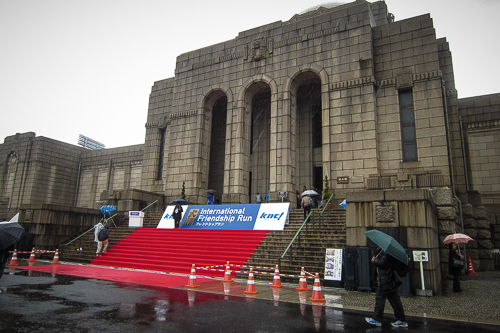
It took more than 200 years before a foreigner set-foot on Japanese soil. “Gaijin” (non-Japanese, or alien), and a little more polite, “Gaikokujin”, (foreigner). Today, a blond ponytail like mine attracts no further attention. Only a Swiss girl who travelled here with her husband and was taking part in the Friendship run commented on my hair style. It only rains an average of 7 days in February in Tokyo and today is one of them. It pours vertically and all the more remarkable that approximately 1,000 overseas runners anchor in the starting area of the Meiji Shrine.
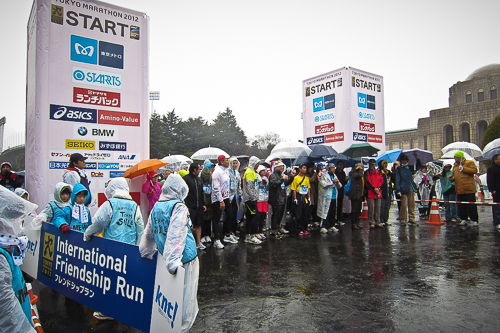
We are tired, freezing and our teeth chatter uncontrollably. With umbrellas, we decide to walk the 2 short rounds of the friendship run, totaling 2 Kilometers. As with most large events the runners are guided into start blocks. The tree tops in the neighboring park appear to salute us in our quest. Despite the inclement conditions the atmosphere is good and the participants are having fun. The course passes the Olympic park where the 1964 games were held and past one of the many golf courses that Tokyo has to offer, before eventually the high rises of Shinjuku dominate the panorama.
One could quite clearly identify the nationality of some of the runners by their dress. French, Dutch, Italians, and so on. A small German flag decorates my socks. I can hardly believe we are here in a port city where in years gone by there were water ways which have since been replaced with motorways. If it rains anymore today motorways will revert back to rivers of water! Before we get washed away we make our way to registration to pick up our start numbers. This takes us through the finish line at the Meiji-Shrine. This was built in 1912 to honor Emperor Meiji and his wife and during the second world war was almost completely destroyed before being rebuilt in 1958. Unfortunately, it lacks the flair of the old shrines and temples that can be found throughout Japan and Tokyo. It is worth mentioning that every year over the New Year festivities millions of people pilgrimage to this famous building. Here, as promised, the awaited breakfast.
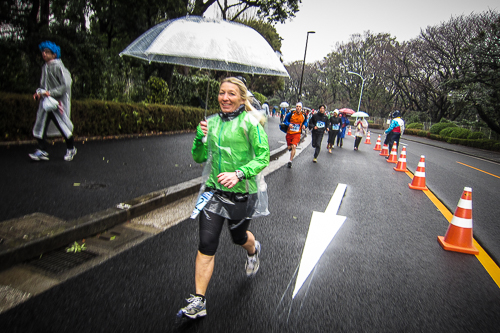
Just follow the queue ahead. First we are given a paper bag. The content; a bottle of water, a bottle of ISO, a banana, 2 chocolate rolls and an energy bar. Now we are handed a paper cup in which we can choose either coffee or green tea. The rain runs off the umbrella like on a lotus leaf and so we are spared wet clothes. However, our shoes are soaked through and our feet cold. It is time to move on.
What can’t you buy?
Once dried, we make our way to the next destination, the four inverted pyramids of the Tokyo Big Sight Exhibition Center. This is easily located once you have mastered the intricacies of the public transport system. Here we will get our start numbers.
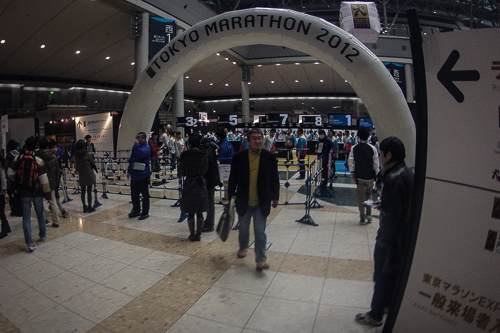
Cordoned off and guarded by helpers. Access is only permissible in the possession of a valid registration confirmation. Everything is highly organized and without hectic. A helper gives me my start package (start number, race chip and oversized clothes bag) with both hands. We bow and smile in the familiar manner.
In the next hall there is a short history of the Tokyo marathon. In show cases the medals and running shoes of the winners. The Tokyo Marathon is rapidly leading to shifts in the ranking of the largest city marathons worldwide. In just a few years it is already on a par with the so called “big five runs”. What is missing, however, is the long standing history as, for example, the Boston Marathon.
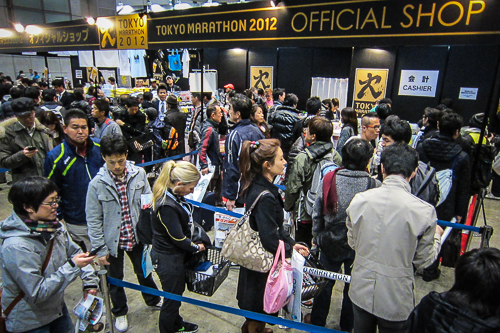
What dominates here is tailored to the masses. Participants are lured into the consumer world of clothes, photos, food and drink. I am looking for something in particular, a carp that I want to attach to my start number. In Japan the carp is regarded as a good luck charm and symbol of endurance and strength. Only at the end of the long corridor, does one receive the event t-shirt, so to speak, as making it through the consumer jungle! Kay with his 1.85 cm stands out amongst the people like a sore thumb. Japanese are on an average 8 cm smaller than the Germans, but therefore, way approximately 19 kilos less. Surely, this must mean my t-shirt size “small” will fit. I tear open the bag and to my disappointment it is too large.
A city does not get enough
It’s crazy, 335,000 runners crowd through the gates of the city, but only 11 percent have received the coveted race number. Who? It is purely the luck of the draw! To be absolutely safe you can book a ticket through a travel agent, which will cost you as a foreigner 110 Euro.
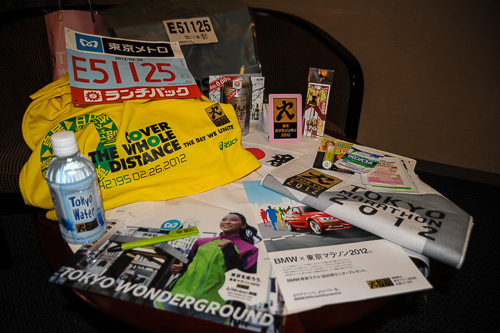
From 1981 through 2006 the Tokyo marathon was called the Tokyo International Men’s Marathon and is today the men’s qualifying event for a coveted ticket to the Olympic Games. More facts: BMW are the official automotive sponsors. 85.920 people visit the sports fair in three days. Over 2 million spectators line the 42.195 km course and cheer the runners on. 40 trucks bring the runners baggage from the start line to the finish line. 30 pace makers ensure for the right finishing time and entertainment. There are 6,000 dancers and musicians, over 5,000 security personnel, 390 medics, 987 toilets and 66 defibrillators and to round the figures off, 2,878 runners from overseas that take part in the 2 kilometer Friendship Run.
The day we unite
That is the motto of the marathon. The rain stopped sometime in the night. Dawn creeps over the houses like a cloth which is drawn from a sculpture. There is a dreary sky above the city where scarcely a ray of sunlight omits through the clouds. Tokyo has it all – just no space. Buildings, cars and people are crowded into this confined city. One has the feeling that the mass of runners and volunteers will burst the seams of an already packed Tokyo.
Madam Butterfly is wearing a start number and Jesus lives
We experience Japan at the highest level of culture: The conductor, who gets off the train, or the road worker who waves a passing car through the construction zone bow as a sign of mutual respect. There is a sick person who is wearing a surgical mask for our protection against infection not theirs. A volunteer takes my XXL clothes bag and places it into a parked truck near the starting line. On my way to the starting block I come across an unusual sight of Japanese tradition, a Geisha. With her face painted white and her brightly colored robe, she looks absolutely spectacular.
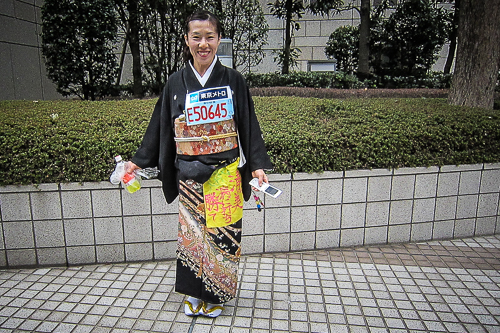
Since the 1800, Geishas have worked in tea houses, and it was their task to entertain the gentlemen with small talk, singing or small tricks. Today they run marathons! In my start block there are already thousands of runners standing between tightly packed business complexes and high rises, that project into the sky like pencils. It is oddly quiet. How can so many people make so little noise? 4 helicopters hover above and instead of “eye of the tiger” classical music plays. Unbelievable, but I can actually hear a bird sing. Then in the distance the start gun sends us off on our way in a rain of confetti. The procession of shuffling runners of all ages moves into gear. Humming like a beehive, the runners make their way through the neighborhood at snail pace. I’m nervous, how does it feel to be pushed through the streets by enthusiastic runners?
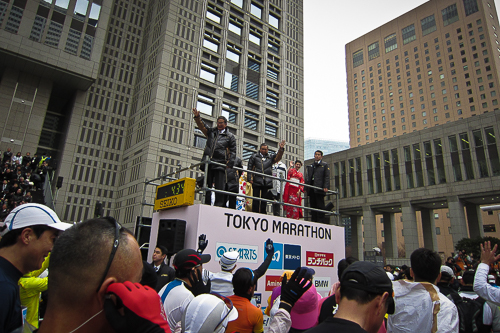
It stands to reason that my “Polar” watch can’t locate a satellite signal. Cheers from spectators greet us from the road side. Not only the Sakura, “cherry blossom”, Hanami festivities bring the people out of their homes in their thousands. Hanami is an important Japanese custom and is held all over Japan in spring. Hanami literally means viewing flowers, but it generally indicates cherry blossom viewing. Cherry blossom festivals take place all over the country. Most of them are held between March and May, though other regions have them in January, February, and June, based on their location. Festival dates are usually determined with reference to cherry blossom forecasts and vary from year to year. The cherry tree and is the official tree of Tokyo and more than 50 percent of the trees in Japan are cherry trees. Nobody is pushing or shoving and I am not being trod on from behind. Runners keep their distance to the man in front. This reminds me of a carnival parade, but without the floats. There is a color of costumes from brilliant to bizarre, from daring to graceful; Mickey and Minnie Mouse, Superman and Batman, and the bride and groom. Between them runs Jesus!
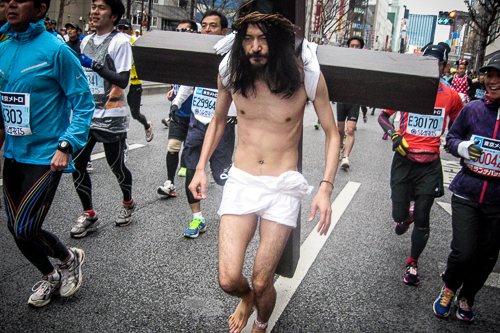
Running through streets that have no numbers or names
There were not always street names in 2 languages. One certainly could not get lost, just follow the crowd. From far away the “Dixi” toilets are recognizable and neat lines of people are already queuing up to use them. The 12 million habitat city is spotless. At this moment my legs are feeling great. No wonder we have been running slightly downhill for nearly 5 kilometers. Cherry trees line the curb and I try to imagine them in full bloom. It’s too late for a photo as I see the bullet train flash by overhead. This is where I see Kay for the first time running along the cordoned off part of the course, trying to take photos.
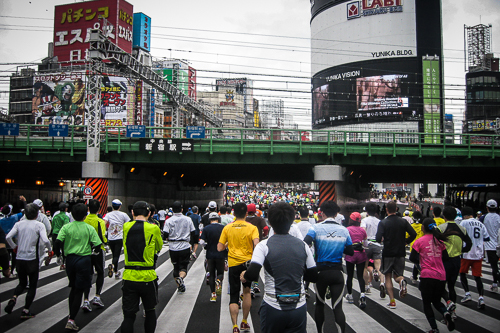
Close by is the 1928 rebuilt train station Lidabashi, that was destroyed in 1923 by the earthquake Kantō which took the lives of approximately 142,800 people. The next highlight on the marathon sightseeing tour is the home of the Tennō (the Japanese emperor). A devastating fire destroyed the main building of the palace in 1873. In 1888, a new building complex was built, but subsequently destroyed during the Second World War and rebuilt again after the war.
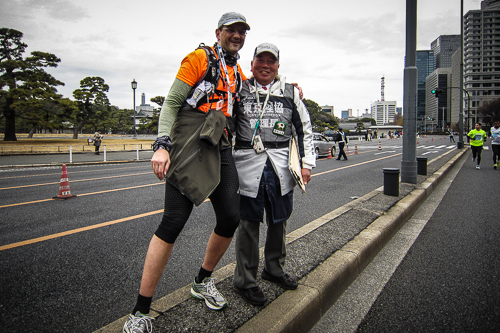
The whole area of the imperial court extends over some 7.5 square kilometers. Jogging around the Imperial Palace is popular. Today I see joggers on the five-kilometer course. There are toilets, drinking fountains, changing rooms and even an electronic timing system for the more competitive runner. This is the perfect set-up for office staff should they wish to go jogging before or after work. There is even an annual charity long-distance team-relay race that runs over this course called “Marunouchi Ekidenand” that is organized by the “Japan Times”.
The palace is only open for tourists twice a year, on the 2nd of January and on the Emperors’ birthday. Who knows, maybe a member of the Emperors’ family is running today or drinking green tea in the neighboring tea house.
In 1600 Tokugawa Ieyasu seized power and established a government at Edo (now known as Tokyo) after he forged a family tree to show he was of Minamoto descent. His title, sei-I taishōgun. The Tokugawa shōgunate lasted until 1867. When the Shōgun resigned, he had to leave the palace and abdicated his authority to Emperor Meiji. During the Edo period, effective power rested with the Shōgun, not the emperor in Kyōto. The Shōgun controlled foreign policy, the military and feudal patronage. The role of the emperor was ceremonial, similar to the position of the Japanese monarchy after the Second World War. The Japanese monarchy is the oldest continuous hereditary monarchy in the world. The current ruling Tennō Akihito is the 125th official monarch. Japan also had female Tennō, reigning empresses. These were but only a temporary solution. They all had to resign as soon as a suitable male descendant was available. And today? Today, women in Japan are football World Champions.
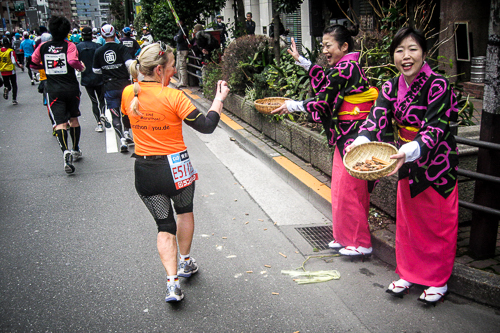
The Nijubashi bridge on the Koyo-Gaien square forms the entrance to the inner palace grounds and can be seen from the course. All of Tokyo seems to be on their feet. The 10 Km runners have now reached the finish line and the “Running Doctors” begin their work. After the earthquakes in Tokyo, it was decided by the city council to modernize the infrastructure for cars and trams by building wider roads. The course reminds me of the Alster in Hamburg. The streets today belong to the runners.
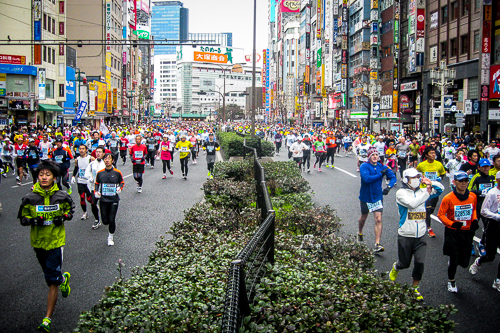
Hey, in the Shiba Park, belly dancers entertain the runners. The next highlight is not far away. At the refreshment areas there are isotonic drinks, water and bananas. Fruit in Japan is classed as a luxury item. The road on which we run is clean. Nothing glues the shoes to the asphalt, no discarded gels, no littering. Everyone throws their trash into the appropriate cardboard boxes.
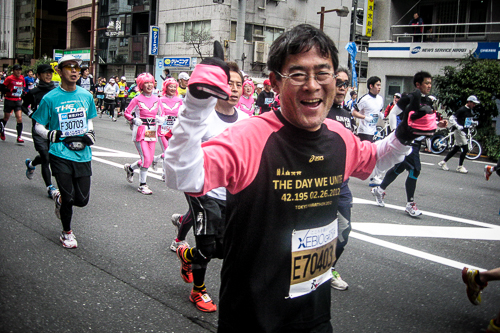
After about 12 kilometers, we run past the Zōjōji temple built in 1393 which borders onto the cemetery and its 15 ton bronze bell, which is struck on December 31st, 108 times following the Buddhist doctrine, known as „Joya no Kane“, in order to dispel the 108 secular desires that plague us. The two-storey main entrance gate, made in 1836, is the most architecturally appealing feature. The inscribed words on the gate: “If a man walks through this gate, he will be redeemed from three afflictions: greed, hatred and stupidity”. One can only imagine how much power was exercised here before the Tokyo Tower and golf driving range were built. The leading group of elite men, are now coming from the other direction and shortly after we pass the Sengaku-ji Temple.
The story of the 47 Rōnin must be one of the best known in Japan. It is a constantly recurring theme at puppet shows, Kabuki plays, television shows and films. In 1701 Prince Asao, provoked by the courtier Kira, drew his sword in the Castle of Edo, an offence, for which he was forced to pay with his life. His followers became masterless Samurai – „Rōnin“. 47 of these followers resolved to avenge their lord. Almost two years later they stormed Kira’s home, killed him and carried his severed head back to Asano’s tomb in triumph. His honor was restored. However, the 47 Rōnin were naturally condemned to death. According to Buddhist Sengakuji custom, lord and followers are buried side by side. The fountain in which the Rōnin washed Kira’s head before presenting it to their lord still stands on the temple grounds. While Germany is still sleeping, the open-air party is in full swing.
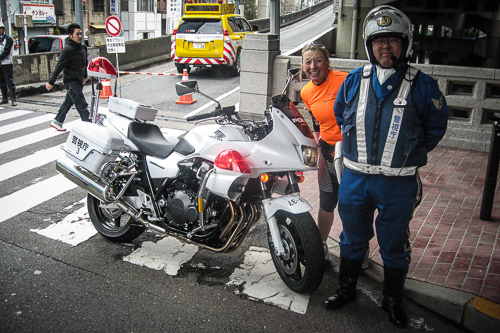
What the Eiffel Tower!
Like the Parisian example, the Tokyo Tower is the tallest self supporting steel tower in the world and is a whopping 13 Meters higher than the Eiffel Tower. It is also 70 years younger. It’s painted bright orange and white and is a big tourist attraction. At kilometer 15 we run through the Shinagawa district and shortly thereafter we reach the turning point. Here at Tōkaidō, during the Edo period, the first post office was opened and it is still in operation today. Some universities and many Japanese companies have established their corporate headquarters here.
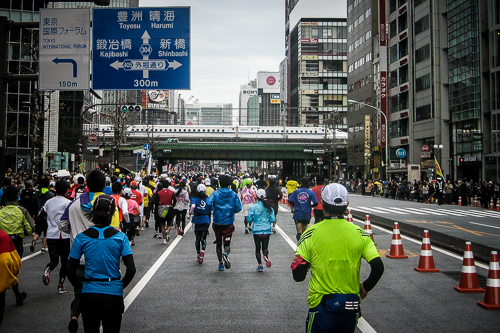
For about 5 Kilometers now I have been able to look into the faces of oncoming runners. Pale skin is considered an ideal of beauty, so I fall into this trend. The yuppies! Yesterday we saw them, dynamic young women in stylish business suits and high heels. The men are no different, chic, elegant, young and dynamic, in their black suits with fashionable ties, white shirts and clean leather shoes. All are dressed in dark colors, tone in tone. Nobody stands out or looks conspicuous. So, where are all the old and elderly people? I can’t find any. I even ask myself, are there any retirees in Tokyo?
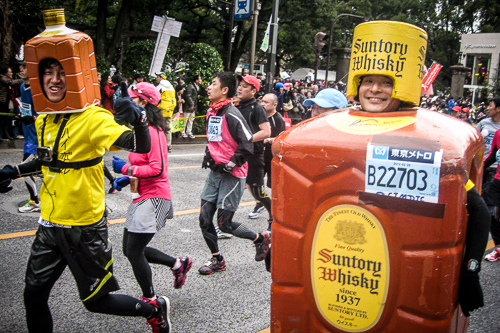
Back on the run course: Today, I feast my eyes on the costumes the runners are wearing. Strangely, two hours on the road and my head is not buzzing from all the hustle and bustle – quite the opposite. I’m caught by the sensation and look forward to running the remaining 20 kilometers.
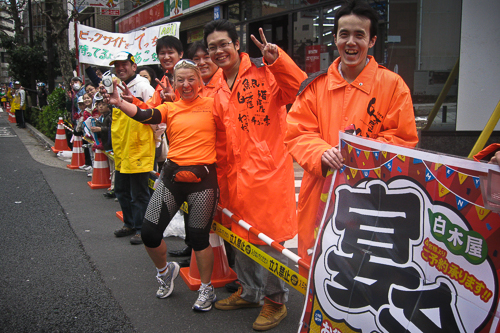
And then there was the Fifth Avenue in New York
The sun appears briefly through the clouds as if to show me what the difference a bit of sun makes when photographing. Shortly after 21 Kilometers we reach the elegant district of Ginza which was built in Parisian fashion at the end of the 19th century by two British architects. Thousands of pairs of sneakers cross over diagonal pedestrian crossings, placed so that during the rush hour there are no jams.
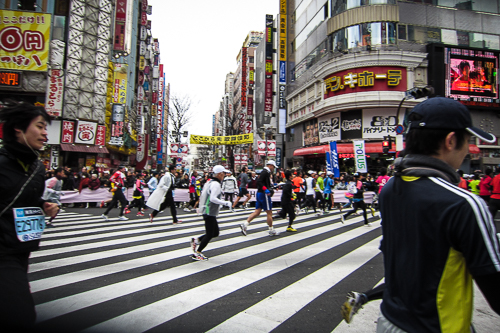
On the main shopping street one discovers only expensive and mainly Western brand shops. The department store Matsuzakaya was the first store where customers could enter without having to first remove their shoes. You can find everything here, just like anywhere else in the world. The future is female! Women are still rarely in managerial jobs, but surely that will soon change. But, in one area women are already unconquerable: as consumers and in Tokyo it is easy to fall into the buying frenzy.
Although Japanese designers like Issey Miyake, Yamamoto have international success, the shopping malls are influenced by Western fashion. Gucci and Armani and almost every modern Japanese woman, possesses a piece of Louis Vuitton. Unfortunately, the city is not for bargain hunters. The city is considered one of the most significant in Asia and the most expensive. Nowhere are the real estate prices as high as here. Even in other neighborhoods one can expect o pay €800 for a 20 square meter apartment. In the evening, the district changes itself like a chameleon with millions of illuminations and neon signs just like on Fifth Avenue in New York.
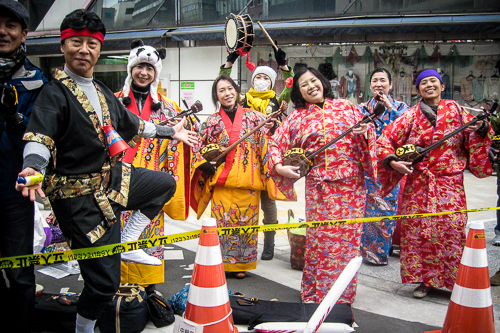
Now I’ve got to go! I managed to find the toilet with the most steps at the Metro station. Each step taken was painful. Whether you speak English or Japanese all the signs are the same for the restrooms. A woman pushes the button on the electric door for me and it opens, which was a good thing, because I don’t know if I would have found the “open sesame” button so quickly. I enjoy the brief moment of tranquility, this moment of happiness in this over- crowded city. The silence is suddenly interrupted by gurgling sounds of water from the toilet seat. Gee, I am sitting on a Tokyo washer. On this heated throne I am my own ruler. Buttons like on a circuit board. A jet of water here, a jet of water there and now a blow dry. What can’t it do? This place reminds me more of a hospital and I don’t think this warm, damp thing would be very decorative in our house back home. Back into the daylight, helpers direct me back into the mayhem, but not before they have checked I have a valid start number.
Forerunner of comics
Kilometer 26. On the other side of the road is the district of Akihabara, which is also known as the electric mile. But there’s not just technical stuff to be found here, it is also the Manga district. Manga means cartoon/comics. Mangas are known to us too. But, that the Manga was first published in 1814 under that name, few know. So many masterpieces found their way over to Europe and Japan and inspired painters such as Paul Gauguin and Vincent van Gogh.
In the distance you can see the Thunder Gate with its huge lanterns. It is a tourist attraction. Behind it lies the Drosselgasse which is also known in the area of the Rhein. The gate is flanked by two grim looking protective Gods. The God of wind, and the God of thunder. Since our arrival, the God of wind has already shown its presence and the God of thunder has so far spared us.
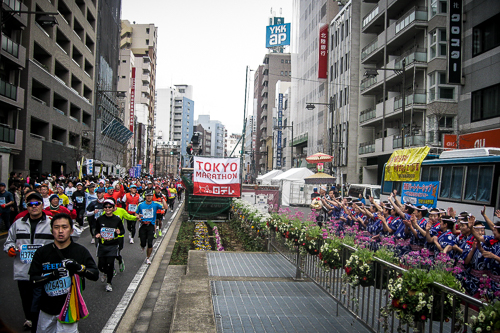
I’ve arrived at the district Asakusa and the atmosphere is tremendous. I stand for a moment absorbing my surroundings. This district is like no other. Here there are many buildings from the 50s and 60s, including a few traditional Ryokan. The oldest and most significant Buddhist temple of Sensō-ji and the Tokyo’s Asakusa Shrine are in the immediate vicinity. Thousands of worshipers visit here every year.
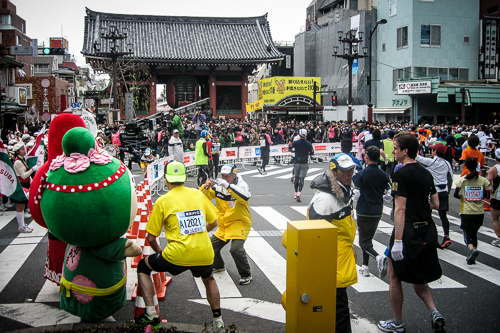
The never ending stream of runners now takes a u-turn and heads back in the direction of Ginza. I can see the recently built Sky Tokyo Tree, with its 634 meters it is the second tallest tower in the world. The side streets boast whole forests of electricity and telephone poles. My feet are tired, but I’m having fun. Stop? No way!
At kilometer 29 we run over a railway bridge over the Sumida River. It is hard to imagine that over 550 years ago only a few houses and a castle stood here. Edo, as the city was then named, first appeared in the history books in the 12th Century. It is said that at that time, a man built a fortified house near the Hirakawa and Suminda estuaries. He called the place and his family Edo. The actual foundation year of the modern metropolis is 1457. Not far from here is also Ryōgoku Kokugikan where every January, May and September the sumo tournaments take place. Also close by, the Kyu-Yasuda-Teien, a famous Japanese garden, and the Edo Tokyo Museum.
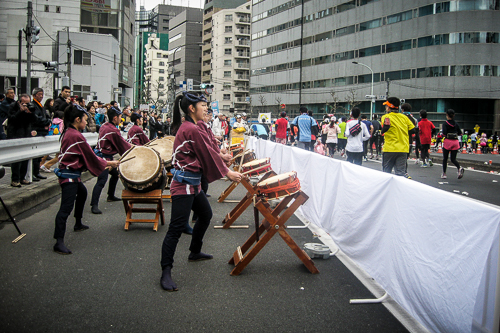
Everywhere it smells different! The glassed high rises reflect the city’s skyline. I feel like a ball in a pachinko gaming house slot machine. All around blinking and flashing. One moment here, one moment there and sometimes the ball just gets stuck. At kilometer 30 and onwards it seems as though the entire population of Tokyo is out on its feet bringing with them sweets and drinks which they share with the runners. At kilometer 35, on the Irigune-bashi Bridge, Japanese women entertain us with their drums, striking the perfect running rhythm.
First we meet Frank and then Michael
“ …. and where did you come from?” I’ve just come from a 3 week bike tour through Vietnam”. I recognized his running top with the words “Fire Department Hannover”. We met Michael in 2009 during a running holiday in Antarctica and here we meet up again surrounded by thousands of Japanese. What a small world. We had tried to meet up with Frank in Germany and also in Mallorca, but it never happened. And now, half way around the world, in Tokyo, we finally make it happen.
Now we are in the famous fish market district of Tsukiji. The historical roots reach as far back as the 16th Century, when the Shōgun Tokugawa Ieyasu brought fishermen from Osaka to Edo, to supply his farm with fish. Today 1600 street traders sell approximately 2.2 million kilograms of fish per day. Some of them monstrosities which should have been better left at the bottom of the sea! We see the legendary puffer fish, the deadliest of all edible fish. We only see it in the form of lampshades at some of the fish monger stalls. When the sun rises, the day’s business has already been taken care of. At km 38 we encounter the first of three bridges.
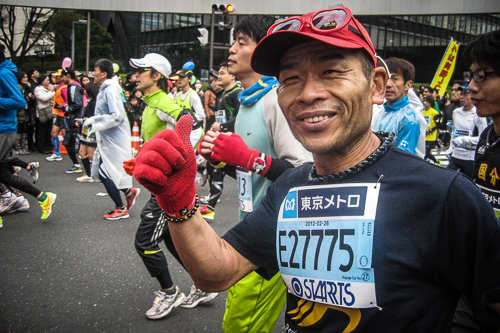
Over and over I am spoken to in German. The German language and culture is still very popular in Japan. This time, I’m spoken to by a man in a Telekom team jersey. He told me that he had lived in Düsseldorf. In the scientific field more than 200 cooperation agreements exist between German and Japanese universities. Germany is currently home to more than 30.000 Japanese, over 7,000 alone in Düsseldorf. The city on the Rhine is the third largest “Japanese city in Europe” behind London and Paris. The spectators are awesome and constantly call out “omedeto gozaimasu!”, “congratulations”.
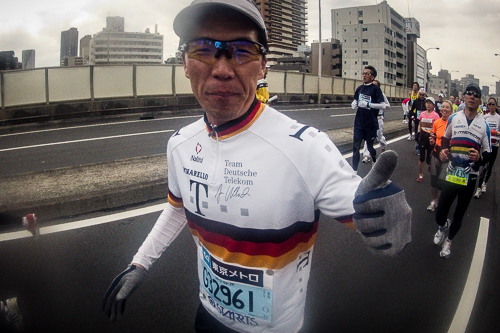
The rise of the bridges is starting to take its toll on some of the runners. I am happy that my muscles have something else to do. We run over the 600 meter long Harumi bridge. This bridge, is built like all the other modern buildings and bridges in Tokyo to withstand earthquakes. When an earth quake hits, and the buildings and bridges sway, life continues on the ground and in the air. Even in Tokyo’s Disneyland, rides automatically stop when the ground quakes, but after a short time continue. At nearly every street corner there are fire extinguishers and large conspicuous signs to draw attention to them. This also explains the tangle of electrical wires above ground that can be quickly repaired after an earthquake.
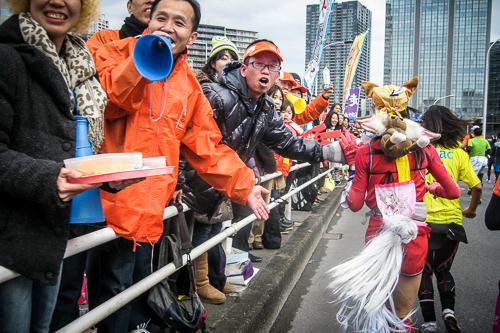
It takes 16 minutes to ride in one of the world’s largest Ferris wheels which I can see in the far distance. We are going to try it out tomorrow. 40 very exciting kilometers lie behind me and I am moved at the thought that I am running here. This amazing district built on the rubble of earthquake Kantō.
The finish line
Sitting on the not quite so packed grandstand at the Tokyo Big Sight are some of the officials from this morning in their dark suits, their clapping restrained. As always after long runs, my legs hurt and my head is buzzing. I see happy faces of runners receiving their medals.
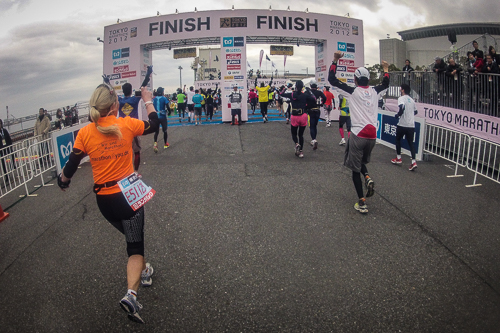
Nobody has to freeze here at the finish line. Nimble hands cover the shoulders of the exhausted and sweaty finishers with large terry towels. This beautiful towel will impress all the club members back home. To run here literally means a mega-city experience and no matter where you are, you’re always in the middle. This becomes evident when I go to pick up my clothes bag. It felt like I had come in with the first runners and that hardly anybody had picked up their after race bag from the reception. That was until I made my way to the changing rooms. There are no showers and every tiny spot is taken up by people desperately trying to get dressed or stretch. People exchange stories whilst taking foot baths and others enjoy a massage.
Still intoxicated by the day’s events I can’t wait to meet up with Kay at the family meeting point, because, only when we are together, are we a team. Long before the official 7 hours are up, Jesus crosses the line. He looks at me with a smile on his face.
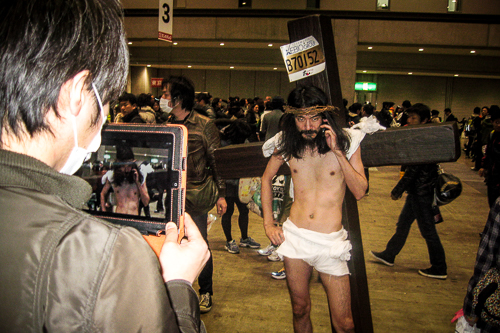
A marathon is more than just a 42 kilometer run. Perfection is a leitmotif of the Japanese culture: perfect weather, perfect helpers with perfect manners, a perfect first aid concept, perfect rules and regulations, perfect supporters and to say it all, perfect organization. Maybe that is also the reason why more than 95% of the runners make it to the finish line.
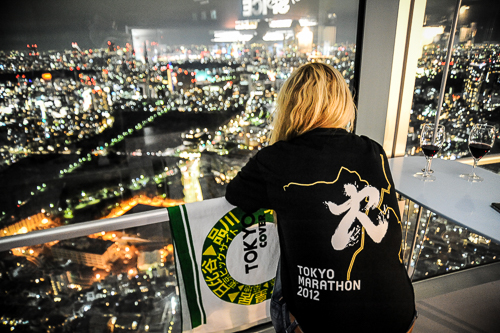
We want to make use of the dazzling lights of Tokyo to take a finisher photo. We make our way up to the 58th floor of the 250 meter above sea level Mori Tower. Here we step out onto the observation deck and are captured by the brilliant night sky and twinkling stars above the artificiality of the incredible city of Tokyo. As the cold wind whistles around our ears, we are engulfed by a feeling of well being: that feeling you get when you are really happy. We are surely blessed to be here.
The statue of liberty in Tokyo and marriage in a mall
In 1902 the first car was imported into Japan, but the population preferred to ride in a Rikscha. The first Economic miracle, with which Japan was surprised by, was the rapid development of the auto industry. The first produced car in Japan was a Nissan. For our day trip a rental car is out of the question: We do not have a translated and certified driver’s license, the highways are subject to toll fees, not all traffic signs are bilingual, there is no parking and here you drive on the left. For many people in Tokyo to own a car is not possible because before you can register a car, you must first prove that you have a parking space for it.
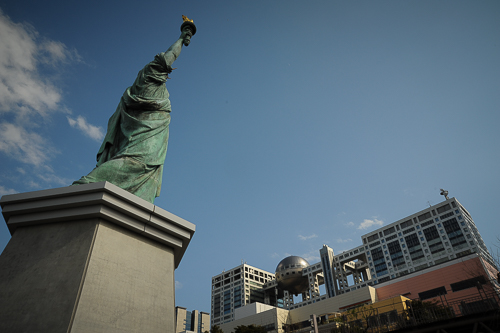
The beautifully kept streets belong to taxis, busses and trucks. Every bumper here is so polished, that I can see my own reflection in them. The majority of people here travel by rail, in some form or another, and even here everything is spotless.
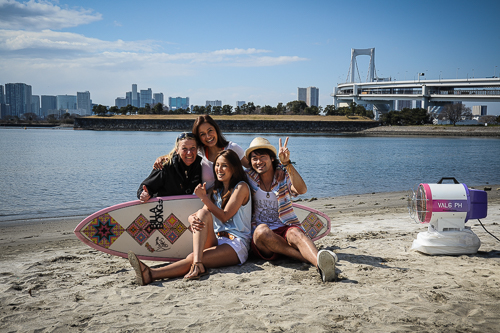
We want to cross the rainbow bridge by foot. The walk across takes about 30 to 45 minutes and offers a spectacular view of the harbor. The rainbow bridge joins Tokyo with the youngest district, the artificial built island of Odaiba. It was initially built for defensive purposes in the 1850s, dramatically expanded during the late 20th century as a seaport district, and has developed since the 1990s as a major commercial, residential and leisure area. This spot is not just popular because of its beaches in the summer, but also when its only 4 degrees to shoot advertising photos on surf boards! A few hundred meters further along, one gets the impression you are in the wrong city because there, stretching her torch into the sky is the statue of liberty. Ok, not quite as big as the original in New York, but still impressive.
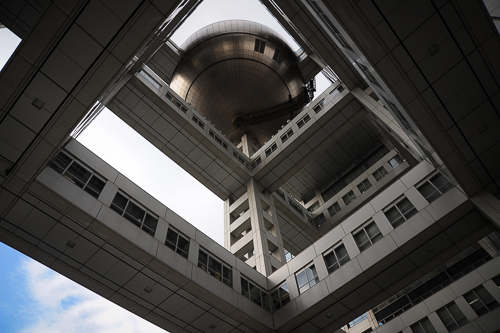
In Japan the color white stands for death. But not for weddings! Weddings are generally celebrated in the Christian manner, even though everything is a fake, from the priest to the Amen. The so called “church” is on the 4th floor of a department store, passing cute little puppies peering out of display cabinets, waiting to be taken home for €4,000. These are the first dogs I’ve seen since I’ve been here. I wonder what happens to them when they become too old to look so cute. One floor up and we find a bike shop. This is something you can’t buy back home, pink inner tubes with matching pink bike chains. What a shame this color clashes with my yellow bike! If you want to try something on, you must first take your shoes off and wear the slippers provided.
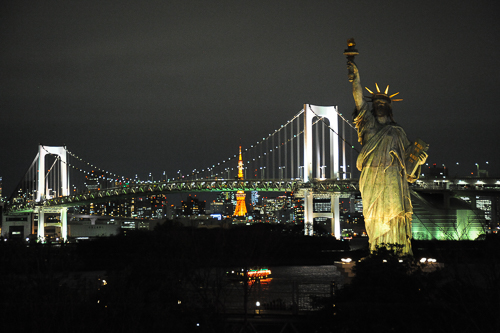
Then there’s the historical museum which happens to be a shop for model cars. Prior to the wedding you can hand your kids over to the nursery. At least the marriage in the fake church has a bonus of a great view of the rainbow bridge and of the skyline of Tokyo. But, nothing is more reminiscent of the commercial bustle behind the closed door.
A duckbill and a name like a monkey
We race on a track at 300 kilometers an hour towards Kyōto which is 540 kilometer from Tokyo. Looking like a duckbill and a name that sounds like a monkey, Shinkansen, (also known as “bullet train”) are the high-speed trains that connect Tokyo with most of the country’s major cities. The opening of the line in 1964 coincided with the Tokyo Olympic Games, a visible symbol to the world that Japan had emerged from the dark days of the war and post-war depression. The Shinkansen is known for its punctuality, comfort and safety, having never had a single fatal accident in its history. Thanks to the Japan Rail Pass, the Shinkansen can also be a very cost effective means of travel.
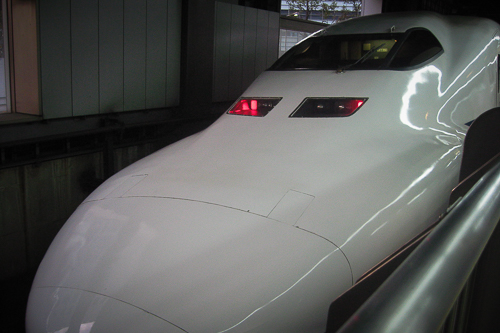
We are firmly pressed against our seats as the train accelerates like an airplane. The “flying” train lays like a motorbike into the turns. I fantasize that the high-tech future is beamed into the glorified past, from the 21st Century into the Kyōto of 794. Over a thousand years ago, Kyōto was the capital of Japan, and the residence of the emperor. In my imagination I see geishas, temples and monks. The countryside flies past. I can see to my left, the Pacific and to my right, the Japanese Alps. We are served coffee. In coach number 14, we are almost alone other than a man, of course, in a pin-stripe suit, working on his laptop. For him it’s a daily trip. For us it’s a journey into another world. Further back someone coughs into their surgical mask. We want to make up for some lost sleep, but I might miss something.
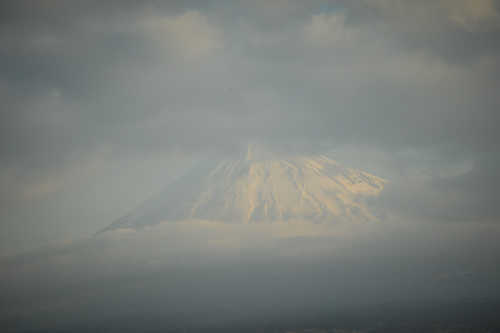
Suddenly, and unexpectedly we see it, just for a split second, Japan’s landmark, the picturesque 3,776 meter Mount Fuji, glinting in the sun. Even before Kay could take off the protective cover from the camera, it had disappeared again behind the clouds. This awesome, majestic mountain covered in snow reminds me of our recent holiday in the Alps. But, this is a sight I’ll never forget. Here one of the oldest poems ever written by the Man’yōshū:
From the bay at Tago
I see, when gazing out,
Pure white-
On the heights of Fuji’s peak-
The snow has fallen.
Our train arrives at its destination in the old imperial city Kyōto. The sun is shining and a brisk and cold wind greets us. Our expectations of wealth, culture, history and nature are soon deflated. We are greeted by a modern railway station, a television tower, post-war buildings from the 70s and a crowded tourist center. No temple in sight and where are the Gods?
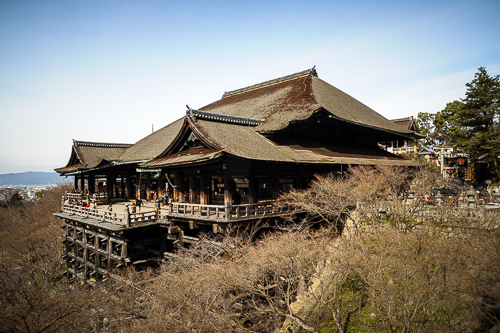
After we figure out the bus timetable, we hop onto a bus that takes us to all the renowned tourist attractions of the seventh-largest city in Japan, Kyōto. Now we can get our first impression of the city, and low and behold, the real McCoy. Like a string of pearls, we pass temple after temple. Not surprising, because in Kyōto there are 270 Buddhist temples and 1,600 Shinto shrines, 17 of which are on the Unesco world heritage site. I see this man, lost in thought. He could be 100 years old. So this is where all the elderly live, the 100s and over.
We get off the bus at the Kiyomizu-dera temple. In the travel guide is states, that the Kiyomizu-dera temple is one of the most celebrated in Japan. 1300 years old, this temple was chosen by Unesco as a world heritage site in 1994. This is a place of worship, peace and magic! Outside a leaf blower roars. The temple teems with school children. The students are wearing uniforms. Each school has its own uniform and emblem. They all look the same and the only thing that makes one stand out from the other are the brand school bags and shoes. The boys wear black suits with gold buttons and the girls wear skirts.
A few steps away from the temple, I see a man exercising Tai Chi. Suddenly frantic agitation. I count eight men in dark blue suits. They all look very important. Everyone wants to help. One of the men guides the ambulance to an injured person, the other 7 look on. The popular expression “jump of the terrace of Kiyomizu” is the Japanese equivalent of “take the plunge,” and at Kiymomizu it means that if one were to jump (it is 13 meters down) and survive, ones wishes would come true! Jumping has been prohibited here, though it was once popular during the 19th century. 234 jumps are documented of which 15% were not successful! It would appear today that the commotion is only a practice rescue operation. We move on.
The Castle Nijō-jō built in 1603 as the Kyōto residence of Tokugawa Shōgun, the first Shōgun of the Edo Period. The castle was built of cedar wood. At the entrance to the living area, we change our shoes for slippers and immerse ourselves in its history.
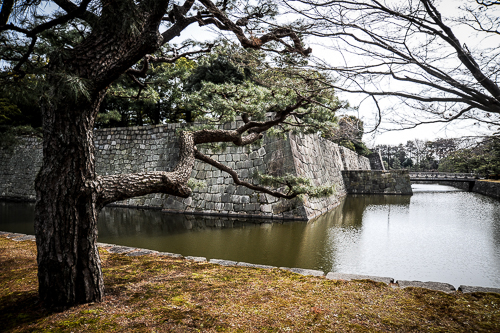
Surviving in its original form, the palace consists of multiple separate buildings that are connected to each other by corridors with so called nightingale floors, as they squeak when stepped upon as a security measure against intruders. Our stomachs growl with hunger! I feel like a monk at a meager meal. Monks used to suppress their hunger by placing heated stones under their clothes.
We are heading to the world famous Zen garden Ryōan-ji. This rock garden was built around 1473. Here you could spend hours absorbed in the sight of the grounds. The garden is rectangle of 340 square meters. Placed within it are fifteen stones of different sizes, carefully composed in five groups; one group of five stones, two groups of three, and two groups of two stones. The stones are surrounded by white gravel, which is carefully raked each day by the monks. The only vegetation in the garden is some moss around the stones. Many different theories have been put forward about what the garden is supposed to represent, from islands in a stream to swimming baby tigers to the peaks of mountains rising above the clouds to theories about secrets of geometry or of the rules of equilibrium of odd numbers. Garden historian Gunter Nitschke wrote: „The garden at Ryōan-ji does not symbolize anything, or more precisely, to avoid any misunderstanding, the garden of Ryōan-ji does not symbolize, nor does it have the value of reproducing a natural beauty that one can find in the real or mythical world. I consider it to be an abstract composition of „natural“ objects in space, a composition whose function is to incite meditation. Garden art was for the Shōguns of ancient Japan a political strategy. They built elaborate gardens for their provincial rulers so that they could not longer afford a war.
There it is, the Kinkaku-ji temple, even if it is only a reconstruction. Back in 1950 an arsonist destroyed this temple leaving only ashes as a reminder of what used to be. Click, click, click! Minolta, Nikon, Panasonic, Canon, and of course iPhone. There is no better known photo motive.
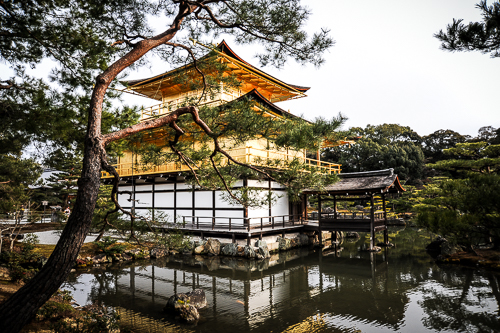
We are blessed for a moment by the sun Gods, as a ray of sunlight falls over the golden temple that is majestically reflected in the lake. One needs time to explore the temples and gardens of Kyōto, something we do not have. We must now return to Tokyo.
Exciting days with an exciting marathon lie behind us. After a final breakfast at the hotel, with Haile Gebrselassie at the next table, we leave the hotel.
The Shōgun elevated Williams to Samurai status and forbade him to ever leave Japan. But, Williams did not want to be stuck in one place, so he organized a new expedition to explore the Northeast Passage, this time from Japan.
I look out of the window of the A380, the snow is falling. Our machine rises high above the clouds into the sun. Below us we fly over Siberia and the Arctic Circle. We will soon be back in Frankfurt am Main.
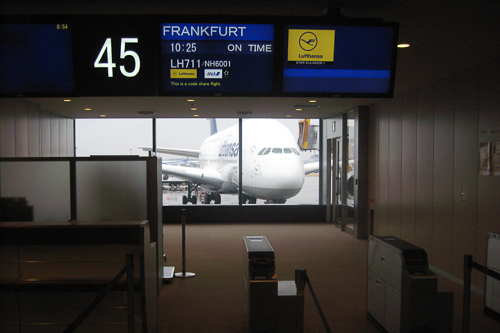
Summary:
In 1870, Europeans were given the task to document East Asia’s culture. We pressed the trigger of our camera approximately 2,500 times. In this article we have presented 600 photos of our trip. What we had not anticipated occurred: Tokyo was more exciting than expected, and is highly recommended for people who want to experience more than just a marathon. Isn’t that why we travel abroad, for those moments where life is bizarrely familiar, but yet different? Such opportunities are priceless.

